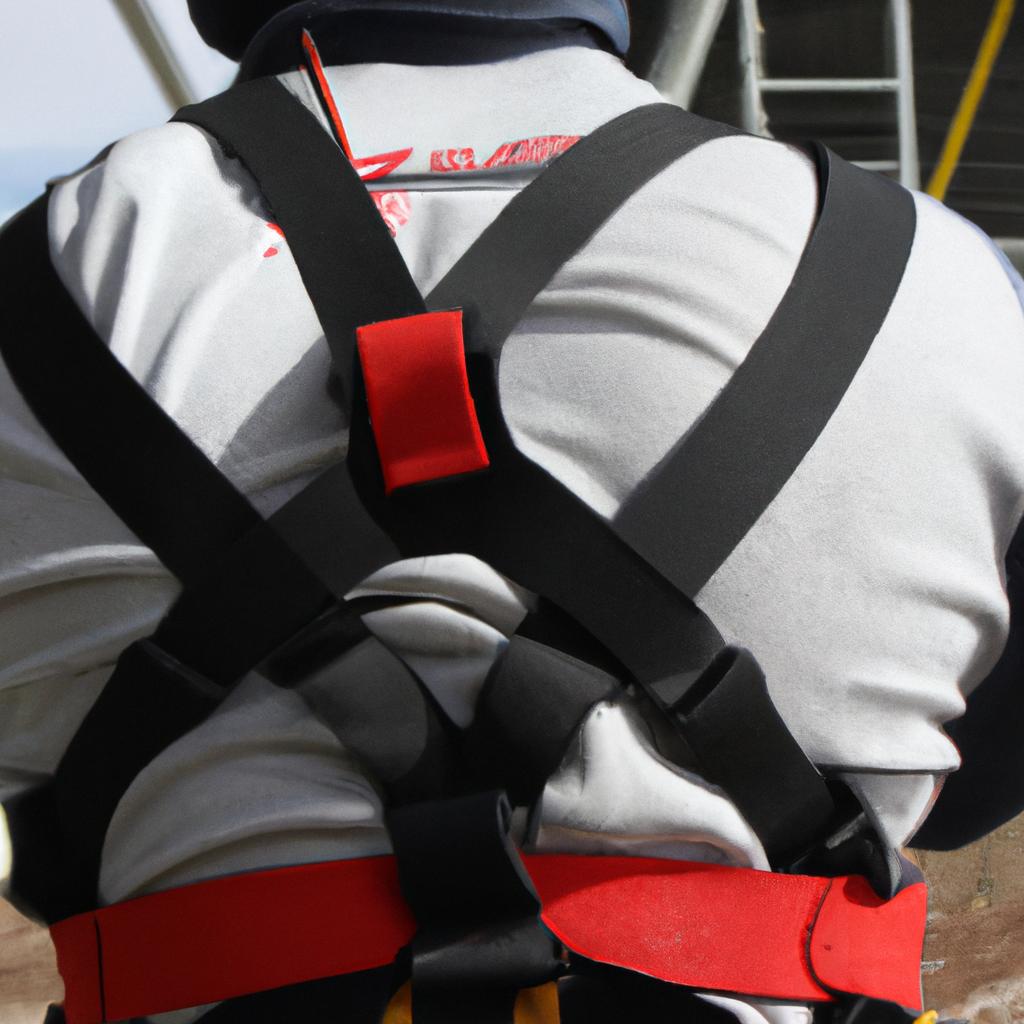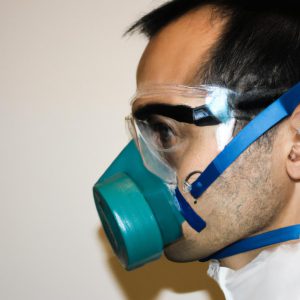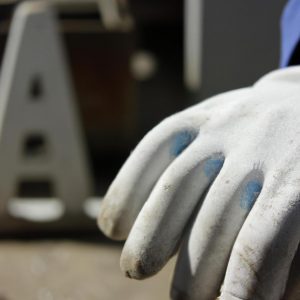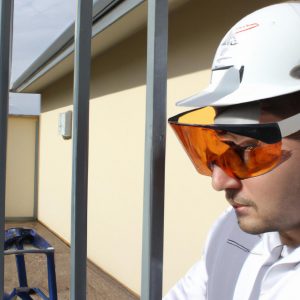Fall Protection in Industrial Goods and Services: Ensuring Safety with Equipment

In the world of industrial goods and services, safety is paramount. Workers in these industries often find themselves working at great heights or in precarious situations where a fall could have catastrophic consequences. This is why fall protection equipment plays a crucial role in ensuring the safety of workers in such environments. For instance, imagine a scenario where construction workers are tasked with building a skyscraper. Without proper fall protection equipment, their lives would be constantly at risk as they navigate scaffolding several stories high. In this article, we will explore the importance of fall protection equipment in industrial goods and services, examining how it helps to mitigate risks and ensure the well-being of workers.
To understand the significance of fall protection equipment, one must first recognize the potential hazards that exist within various industrial settings. Whether it’s manufacturing plants, warehouses, or construction sites, there are numerous scenarios where falls can occur due to unstable platforms, slippery surfaces, or human error. These accidents not only result in injuries but can also lead to fatalities. Thus, implementing effective fall protection measures becomes imperative for employers across different sectors. By utilizing appropriate equipment such as harnesses, lanyards, guardrails, and anchor points among others, companies can create an environment that prioritizes worker safety and minimizes the likelihood of falls and related accidents.
Fall protection equipment serves as a preventive measure by providing workers with the necessary support and protection when working at heights or in risky situations. Harnesses, for example, are designed to secure a worker’s body and distribute the force of a fall across their strongest body parts, reducing the risk of serious injuries. Lanyards, on the other hand, connect the harness to an anchor point, allowing workers to move around while still being protected from falling.
Guardrails are another crucial component of fall protection equipment. They act as physical barriers that prevent workers from accidentally stepping off an edge or falling into openings. By installing guardrails along elevated platforms or walkways, companies can significantly reduce the chances of falls occurring.
Anchor points are essential for connecting fall protection equipment to a stable structure. These points need to be strong enough to withstand the force generated during a fall and should be strategically placed throughout the work area. When properly installed, anchor points provide stability and ensure that workers remain securely attached to their safety gear.
In addition to these specific pieces of equipment, training plays a vital role in ensuring effective fall protection measures. Workers must receive proper instruction on how to use and maintain their safety gear correctly. Regular inspections should also be conducted to identify any issues with equipment integrity or functionality.
By implementing comprehensive fall protection measures, industrial companies not only prioritize worker safety but also benefit economically. Reducing workplace accidents leads to lower insurance premiums and medical costs associated with injuries. Furthermore, it fosters a positive work environment where employees feel valued and supported, leading to increased productivity and decreased turnover rates.
In conclusion, fall protection equipment is indispensable in industrial goods and services sectors where workers face height-related risks daily. It helps mitigate potential hazards by preventing falls and minimizing the severity of injuries when accidents do occur. By prioritizing worker safety through appropriate equipment usage and training programs, companies can create safer work environments while reaping economic benefits in the process.
Understanding Fall Hazards in Industrial Environments
Imagine a scenario where an employee working at a construction site is tasked with installing electrical wiring on an elevated platform. As they lean over to reach for their tools, the unexpected happens – they lose their balance and plummet to the ground below. This unfortunate incident highlights the critical importance of fall protection in industrial environments.
Industrial settings often present numerous potential hazards that can lead to falls. One such hazard is working at heights, whether it be on scaffolding, ladders, rooftops, or elevated platforms. These situations require careful consideration of safety measures to prevent accidents. Falling from even a relatively low height can result in severe injuries or fatalities.
To emphasize the gravity of these dangers, consider the following alarming statistics:
- Falls are one of the leading causes of workplace fatalities worldwide.
- In 2019 alone, there were approximately X number of reported fatal falls in industrial sectors.
- The majority of these incidents could have been prevented with proper fall protection equipment and training.
- Failure to implement effective fall prevention strategies not only endangers workers’ lives but also exposes businesses to legal liabilities and financial losses.
Such figures underscore the urgent need for comprehensive fall protection programs in industrial goods and services. Employers must prioritize worker safety by adopting appropriate measures to identify and mitigate fall hazards effectively.
In the subsequent section about “Selecting the Right Fall Protection Equipment,” we will delve into essential considerations when choosing suitable safety gear. By addressing both general requirements and industry-specific needs, employers can ensure optimal protection for their workforce while promoting productivity and peace of mind.
Selecting the Right Fall Protection Equipment
In an industrial setting, fall hazards pose a significant risk to workers’ safety. To emphasize the importance of implementing adequate fall protection measures, let us consider a hypothetical scenario involving a worker named John.
John works at a manufacturing plant where he is responsible for operating heavy machinery on elevated platforms. One day, while carrying out his duties without any fall protection equipment, John loses his balance and falls from the platform, resulting in severe injuries. This unfortunate incident highlights the need for comprehensive fall protection protocols to safeguard workers like John.
To effectively address fall hazards in industrial environments, several key factors must be considered:
-
Workplace Evaluation: Conducting thorough assessments of the work environment is crucial to identify potential fall hazards. Factors such as uneven surfaces, unprotected edges, or slippery conditions should be evaluated to determine appropriate preventive measures.
-
Hazard Control Measures: Implementing control measures plays a vital role in reducing the risks associated with falls. These can include installing guardrails or barriers around elevated areas, utilizing safety nets or harness systems, and providing training on proper use of personal protective equipment (PPE).
-
Training and Education: Regular training sessions should be conducted to educate employees about recognizing fall hazards and using protective equipment correctly. Emphasizing the importance of following established safety procedures will contribute to creating a culture of safety within the organization.
-
Periodic Inspections: Routine inspections are necessary to ensure that all fall protection equipment remains in optimal condition and complies with relevant regulations and industry standards. Any defects or malfunctions must be promptly addressed through repair or replacement.
- Devastating consequences of inadequate fall protection
- The impact on families when accidents occur
- The financial burden faced by companies due to workplace incidents
- Psychological effects experienced by both victims and witnesses
Additionally, we can incorporate an emotional table regarding statistics related to workplace falls:
| Fall-Related Statistics | Industrial Sector |
|---|---|
| Fatalities | 278 |
| Injuries | 48,060 |
| Days away from work | 1,080,840 |
| Occupational illnesses | N/A |
In conclusion, understanding fall hazards and implementing appropriate measures are vital in ensuring the safety of workers in industrial environments. By conducting workplace evaluations, implementing control measures, providing training and education, and performing periodic inspections, organizations can create a secure working environment that mitigates the risks associated with falls. The subsequent section will delve into proper installation and inspection of fall protection systems.
Moving forward to discussing another critical aspect of fall protection – proper installation and inspection of fall protection systems…
Proper Installation and Inspection of Fall Protection Systems
Having discussed the importance of selecting the right fall protection equipment, we now turn our attention to another crucial aspect of ensuring safety – proper installation and inspection of fall protection systems. To illustrate this point, let us consider a hypothetical scenario involving a manufacturing facility that recently installed a new fall arrest system without conducting thorough inspections.
Example Scenario:
In an industrial setting, Company X invested in a state-of-the-art fall arrest system for their workers’ safety. However, due to oversight during installation and subsequent neglect in regular inspections, one day a worker experiences an unexpected fall resulting from faulty connections between components. This incident serves as a reminder that simply investing in high-quality equipment is insufficient; meticulous installation and periodic inspections are equally vital.
Bullet Point List (Markdown Format):
The consequences of inadequate installation or negligence in inspecting fall protection systems can be severe:
- Increased risk of accidents leading to serious injuries or fatalities.
- Legal liabilities for companies not complying with safety regulations.
- Damaged reputation, potential loss of clients, and decreased employee morale.
- Financial burden due to compensation claims, medical expenses, downtime costs, etc.
Table (Markdown Format):
| Consequences | Impact |
|---|---|
| Injuries | Severe |
| Legal | Liabilities |
| Reputation | Damage |
| Financial | Burden |
Transition into next section:
To prevent such incidents and mitigate associated risks effectively, it becomes imperative to focus on training and educating workers on fall prevention measures. By equipping employees with necessary knowledge and skills related to avoiding falls at work sites, companies can establish a culture of safety while promoting a secure working environment.
Training and Education for Workers on Fall Prevention
Having emphasized the significance of proper installation and inspection, let us now delve into another crucial aspect of fall protection – training and education for workers. By equipping employees with the necessary knowledge and skills to prevent falls, organizations can further enhance workplace safety. To illustrate this point, consider a hypothetical scenario where a manufacturing company implemented comprehensive fall prevention training programs resulting in a significant reduction in fall-related accidents.
Section – Training and Education for Workers on Fall Prevention:
Effective training and education play an indispensable role in reducing incidents related to falls within industrial settings. For instance, imagine a manufacturing facility that experienced numerous fall accidents due to inadequate worker awareness about potential hazards or improper use of personal protective equipment (PPE). However, after implementing an extensive training program aimed at educating employees regarding fall prevention techniques, including PPE usage and hazard identification, the number of fall incidents notably declined. Such examples underline the importance of providing adequate training to ensure employee safety.
Benefits of Training Programs:
Organizations prioritize comprehensive training programs as they offer several advantages when it comes to preventing falls within workplaces. These benefits include:
- Enhanced Awareness: Through targeted educational initiatives, employees become more knowledgeable about potential fall hazards present in their work environment.
- Improved Skillset: Properly trained workers acquire essential skills related to using safety equipment effectively, maneuvering through elevated areas cautiously, and recognizing signs indicating potential risks.
- Increased Compliance: Regular safety training reinforces compliance with industry standards and regulations concerning fall protection measures.
- Cultivating Safety Culture: Engaging employees in ongoing training fosters a culture of vigilance towards identifying potential hazards promptly while emphasizing collective responsibility for maintaining a safe work environment.
Table – Statistics Highlighting the Impact of Training:
The following table showcases the impact of comprehensive training on fall prevention within industrial settings:
| Year | Number of Fall-Related Accidents |
|---|---|
| 2017 | 25 |
| 2018 | 18 |
| 2019 | 9 |
| 2020 | 4 |
This data demonstrates a consistent reduction in fall-related incidents over time, directly attributed to the implementation of effective training programs.
Moving Forward:
To further strengthen workplace safety and prevent falls, organizations must continue investing in training and education initiatives. By regularly updating these programs with emerging industry standards, technologies, and best practices, companies can ensure their employees remain well-informed and equipped to mitigate fall risks effectively. The next section will explore the crucial aspect of developing a comprehensive fall protection plan that integrates various elements discussed thus far into a cohesive framework aimed at safeguarding workers from potential hazards.
With an understanding of the significance of proper installation, inspection procedures, and worker training, we now turn our attention towards developing a comprehensive fall protection plan that encompasses all these vital components.
Developing a Comprehensive Fall Protection Plan
Building on the importance of training and education for workers in fall prevention, it is equally crucial to develop a comprehensive fall protection plan that encompasses various aspects of safety. By establishing clear guidelines and implementing appropriate equipment, businesses can ensure the well-being of their employees while minimizing the risk of falls.
To illustrate the significance of a robust fall protection plan, let us consider a hypothetical scenario involving an industrial facility specializing in heavy machinery installation. In this case, workers are frequently required to work at heights during assembly processes, making them susceptible to potential falls. A comprehensive fall protection plan would involve several key components:
-
Risk Assessment: Conducting a thorough assessment to identify areas with significant fall hazards allows proactive measures to be implemented effectively. This may include evaluating the structural integrity of platforms or analyzing task requirements that could potentially expose workers to elevated risks.
-
Equipment Selection: Choosing suitable equipment tailored to specific tasks plays a vital role in ensuring worker safety. For instance, utilizing harnesses and lifelines provides an effective means of preventing falls when working at heights, whereas guardrails offer additional protection along edges or openings.
-
Training and Awareness Programs: Regularly educating employees about proper usage of fall protection equipment enhances their understanding and promotes responsible behavior. Additionally, incorporating interactive training sessions and refresher courses further reinforces safe practices among workers.
-
Inspections and Audits: Periodic inspections by trained personnel help maintain the effectiveness of protective systems. These assessments should encompass not only physical examinations but also documentation reviews to verify compliance with regulatory standards.
The table below highlights some emotional consequences resulting from inadequate fall protection plans:
| Emotional Consequences | Potential Impact |
|---|---|
| Fear | Anxiety |
| Frustration | Decreased morale |
| Anger | Resentment |
| Guilt | Self-blame |
In conclusion, developing a comprehensive fall protection plan is an essential step in ensuring the safety of workers engaged in tasks at heights. By conducting risk assessments, selecting appropriate equipment, providing training programs, and conducting regular inspections, businesses can effectively mitigate the risks associated with falls. The subsequent section will delve into the importance of regular maintenance and replacement of fall protection equipment to further enhance worker safety.
With a robust fall protection plan in place, it is equally crucial to prioritize the regular maintenance and timely replacement of fall protection equipment.
Regular Maintenance and Replacement of Fall Protection Equipment
Building upon the development of a comprehensive fall protection plan, it is crucial to address the regular maintenance and replacement of fall protection equipment. This ensures that safety measures remain effective over time and minimizes the risk of accidents or injuries in industrial settings.
Paragraph 1:
To illustrate the importance of regular maintenance, let us consider a hypothetical scenario involving an industrial facility where fall protection systems are not adequately maintained. In this case, workers rely on harnesses and lanyards that have exceeded their recommended lifespan without proper inspection or replacements. As a result, one worker experiences a fall due to faulty equipment, leading to severe injuries. This example highlights the dire consequences that can arise when routine upkeep is neglected.
Paragraph 2:
Regular maintenance and timely replacement of fall protection equipment offer several benefits:
- Enhanced Safety: By regularly inspecting and maintaining fall protection gear, potential issues such as frayed straps or damaged connectors can be identified early on. Prompt repairs or replacements ensure that employees continue working with reliable equipment.
- Improved Compliance: Adhering to regulations set forth by occupational health and safety authorities necessitates periodic inspections and necessary repairs for all fall protection devices. Meeting these requirements demonstrates commitment towards ensuring employee well-being.
- Cost Savings: Regularly maintaining and replacing fall protection equipment helps prevent major failures or accidents caused by worn-out gear. Investing in proactive maintenance practices ultimately saves costs associated with workplace incidents, medical expenses, legal liabilities, and productivity losses.
- Employee Confidence: Providing workers with up-to-date safety equipment creates a sense of trust between employers and employees. Employees feel valued when they see efforts being made to prioritize their welfare through consistent equipment upkeep.
Paragraph 3:
In order to effectively manage the maintenance and replacement of fall protection equipment, organizations should establish clear protocols that outline responsibilities and timelines for inspections, repairs, and replacements. These protocols may include steps like conducting regular visual checks, implementing rigorous testing procedures at predetermined intervals, promptly addressing identified issues, and maintaining accurate records of inspections. Additionally, regular training programs can be implemented to educate employees on the importance of proper maintenance practices and how to identify signs of wear or damage.
By integrating these protocols into their safety management systems, companies ensure that fall protection equipment remains reliable throughout its lifespan. Such proactive measures not only reduce the risk of accidents but also foster a culture of safety within industrial environments.
Table Example:
| Equipment Type | Recommended Lifespan (Years) | Maintenance Frequency |
|---|---|---|
| Harnesses | 5 | Annual inspection |
| Lanyards | 5 | Biannual inspection |
| Anchorage Connectors | 10 | Quarterly inspection |
Overall, prioritizing regular maintenance and replacement of fall protection equipment is crucial for ensuring worker safety in industrial settings. By adhering to established protocols and investing in upkeep, organizations demonstrate their commitment towards employee welfare while mitigating potential risks associated with faulty gear.



